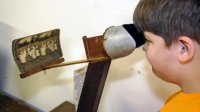Using Creative Projects to Help Students Engage With History
When students work with primary source materials, they produce authentic work that both drives and demonstrates their learning.
Your content has been saved!
Go to My Saved Content.When students engage with historical materials in creative ways like producing podcasts and photography projects, they find the work deeply meaningful, writes history teacher Sarah Cooper in “6 Takeaways From a History Podcast Project” for MiddleWeb. By working with primary source materials, students not only gain a better understanding of history but also develop skills needed to process current events, she says.
When the pandemic required a change in the way she taught, Cooper devised a podcast project for her eighth graders. Before they began recording, she shared several professionally produced podcasts with them so they could hear what they might create; she selected a wide variety of styles and lengths so they could imagine different possibilities for their work. Cooper asked her students for feedback on what they heard, what they learned, and how it made them feel.
In another pandemic-related project, photography teacher Wendy McElfish introduced her students to the work of Depression-era documentary photographer and photojournalist Dorothea Lange. Instead of assigning a report on Lange, McElfish tasked her students with taking photos in Lange’s style. “I want you to look at these photos and then create,” she told them. Using the professional images as a model, students shot their experiences in isolation. “I had the students edit in black-and-white because I wanted to emulate the photos of the Great Depression.”
For her podcast project, which students completed in groups, Cooper provided a choice of nine historical events—eight conflicts, plus the Great Depression. Cooper wrestled with how much foundational information to convey at the outset and how much she should let students find on their own. She concluded that the decision depends on the circumstances, but regardless of how much teachers front-load information, they should frequently check in with students working independently to ensure they’re working with accurate information.
Cooper recommends encouraging students to use primary sources and emphasizing “from the beginning that primary sources are the ‘stars’ of the podcast—and that secondary historical context needs to wrap around these sources, not overwhelm them.” Beginning with primary sources allows students to exercise critical thinking skills—deciding what to include in their podcast pushes them to evaluate the merit of each artifact.
Interviews are another valuable way for students to explore history. They can be used to make a personal connection between students and family members or friends who lived through historic events. For example, one of Cooper’s students “interviewed grandparents about being in Korea at the time of the Korean War, another talked with a grandfather about living in a group home during the Great Depression, and still another spoke with family members about a relative’s death in the Iraq War.” Tracing events through the eyes of people who experienced them can give students a more nuanced understanding of history.
When designing a historical project, the final assessment may be less formal than with other assignments, Cooper says. “Grading while walking around is a pleasure,” she writes, noting how she could recall the best parts of student podcasts without referring to any notes. The same concept applies to students: Creating an engaging project can reinforce learning and retention. As one of Cooper’s students observed, “I feel that I remember the info better because I had to work to make it appealing to others to listen to.”
